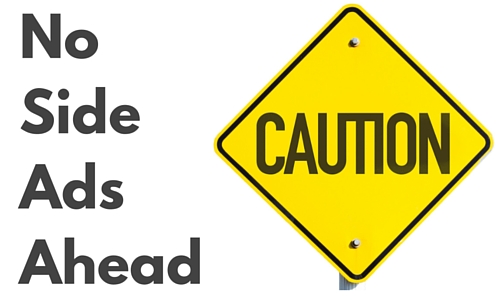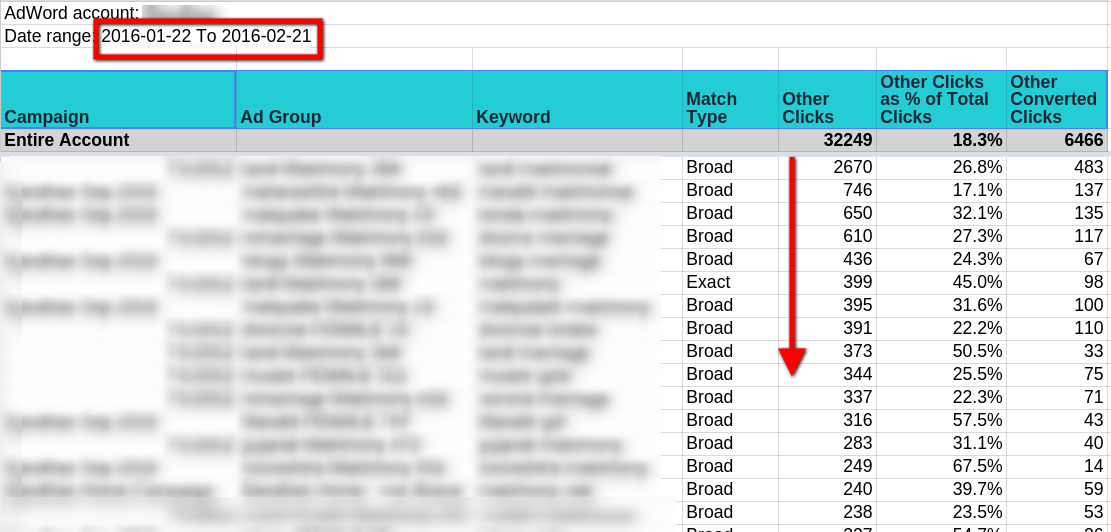[Update on 29th Feb: There is an important update at the end of this post. ]
While Google has been testing 4 ads on top of the desktop search result page and no side ads, these tests were just that. Tests. Last weekend, Moz found that Google has moved to 4 top ads format. The same was confirmed by Google to Search Engine Land.

Aaron Levy of EliteSEM published an extremely well-researched post on the impact of this change. Matt Umbro of Hanapin Marketing also weighed in with data from 3 different accounts on potential impact of this change. These two posts have covered the topic in detail. If you are not fully aware of the issue, you may read those two articles before you proceed here. Really!
Now, that you have received all the gyaan from the masters, here’s an AdWords Script to help you quickly identify the keywords that may be under threat of losing substantial amount of valuable traffic. You can get this data by using the “Top Vs Other” segment report in AdWords, but it is not intuitive.
The Result
Let’s start with the final result you will see with this script. This script will give you a sheet which shows the keywords with highest number of clicks from Side positions. (Here, I’m using the term “Side Position”, but technically, it includes ad shown on side positions as well as the bottom of the search result page ads.) The results are sorted by number of clicks on the side position.
The first row provides the summary of the entire account. This account received 18% clicks on the side position in last one month (check the highlighted date range). From the next row onwards, you will see numbers for each keyword (along with its match type, ad group and campaign name). Here, the first keyword received 2670 clicks from the side position. Side position clicks were 26.8% of total clicks received by this keyword in last 30 days. You will also be able to see how many conversions were received by this keyword when appeared in the side position.
Looks useful, right?

With this report in hand, you will be able to identify keywords that may lose most clicks, click share and conversions. You may decide to raise bids on keywords that are valuable to you. If you are part of an agency, you can send a quick heads up to your clients about potential loss of traffic from AdWords.
OK, Where’s the Script?
If you are in a hurry or you have working knowledge of AdWords scripts, here’s the script to identify keywords impacted by zero side ads. Have fun with the script.
Rest of you who have stayed back to know a bit more about the script, here’s how you can customize it to get it working for you.
- SPREADSHEET_URL : This is the Google Sheet which will have the result once you execute the script. Create a new sheet with Google Sheet and copy-paste URL of that sheet in place of ‘https://docs.google.com/YOUR-SPREADSHEET-URL-HERE’.
- START_DATE and END_DATE : This will define the duration of the data to be considered for the report. The date format is “yyyy-mm-dd” aka “Year-Month-Date.” For example, if you want a report from last quarter of 2015, the START_DATE would be “2015-09-01” and END_DATE would be “2015-12-31.” Currently, we have set the range from 22nd January, 2016 to 21st February, 2016.
- IS_MCC_ACCOUNT : This flag is to indicate whether you will be running this script at MCC-level. By default, it is set to false. Change it to “true” if you want to use for all the linked accounts in your MCC account. The results for each account will be stored in a separate sheet. Be careful, if you have many many accounts.
- IGNORE_PAUSED_CAMPAIGNS and IGNORE_PAUSED_ADGROUPS : These flags indicate to ignore paused campaigns and ad groups. By default, these are set to true. All paused keywords are ignored by default.
- MAX_KEYWORDS : You will get report for top 1,000 keywords (ordered by side clicks in decreasing order) in the account. You can get results for more keywords by changing the value here.
- FILTER_ACCOUNTS_BY_LABEL : If your MCC account has tons of linked accounts, you may not want to run this script for all the accounts. In that case, turn this flag to “true” and then specify the label with ACCOUNT_LABEL_TO_SELECT variable. Only the accounts with the specified label will be analyzed to generate this report.
- FILTER_ACCOUNTS_BY_IDS : Same as filtering by label, but instead of label, you can specify individual account IDs. Set this flag to true and specify the account IDs in ACCOUNT_IDS_TO_SELECT array to get the reports for those accounts.
That’s it. Here’s the script to identify keywords impacted by zero side ads. Once you run the script, it will give you the actionable data within seconds.
If you have any questions or feedback about the script, please leave a comment or send an email to shashi AT karooya.com.
[Important Update on 29th Feb] We have published another script that will find the true impact of this change. Go ahead and grab that script as well.
Get all the AdWords scripts published by Karooya
Related Articles:






Joe
This is a great script. And the developer modified it after I made a feature request in a few hours… If you manage a lot of accounts using this at the MCC level is a must!
Shashikant
Happy to help, Joe! 🙂
Ben
You show how to identify the keywords that received the most clicks from the RHS…But how can you easily see performance on those same keywords since the change was rolled out?
Ben
You show the stats to locate the keywords that received the most clicks from the “side”. But since the change went into effect on the 22nd, how do you see the impact on those same keywords? Isn’t that the most important piece of information.
Randy Milanovic
I say embrace the minimalist view while its here. It won’t last long. Google will change it again in a couple months.
Neale Gilhooley
Google seems to be pushing us towards the Display Network which for many clients is of little or no value at all and the page impressions are of even less use.
Thanks for the script!
Rodney
What do you do with this script? Do you put it in a text file on your website?
Kirti
Hi Rodney,
Here’s how you can use the script: https://developers.google.com/adwords/scripts/docs/your-first-script